Text

5 Cents, Issued by, British East Africa (Kenya, Tanganyika and Uganda), 1936 KN
Minted by King's Norton Mint, Birmingham
Struck in the name of King Edward VIII
Obverse Description
A central hole with curved floral design to left and right; above hole, crown; below hole in two lines, FIVE / CENTS; around, EDWARDVS VIII REX ET IND: IMP: and the mint mark, KN below the denomination
Reverse Description
Curved around central hole four elephant tusks; above hole, 5; around outside line circle, EAST AFRICA 1936
0 notes
Text
As a strategic location in the Eastern Mediterranean, Cyprus has been contested and occupied by various powers since antiquity; it was successively ruled by the Assyrians, Egyptians, and Persians before Alexander the Great seized it in 333 BC.

Cyprus subsequently formed part of the Ptolemaic Kingdom until it was annexed by Rome in 58 BC. It remained part of the Eastern Roman Empire for the next thousand years, albeit intermittingly coming under Arab control, sometimes jointly with the Romans. The French Lusignan dynasty took control of the island during the Third Crusade of the late 12th century, succeeded by the Venetians in the late 15th century, from whom Cyprus was subsequently conquered by the Ottomans in 1571.
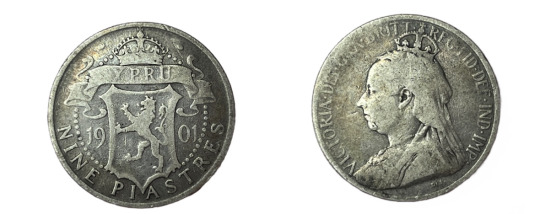
The Ottoman period saw major demographic, political, and cultural changes, including the emergence of Greek nationalism. The island was secretly placed under the British administration under the Cyprus Convention of 1878 after after the Russo-Turkish War.

In 1915, Cyprus was formally annexed into the British Empire after the Ottomans had entered World War I on the side of the Central Powers against the British, and it was initially governed by a military administration until 1925, when it was proclaimed the Crown Colony of Cyprus.

In the 1950s Greece recovered economically, and diplomatic and trade links were strengthened by King Paul’s state visits abroad. He became the first Greek Monarch to visit a Turkish Head of State. However, links with Britain became strained over Cyprus, where the majority Greek population favored union with Greece, which Britain, as the colonial power, would not endorse.
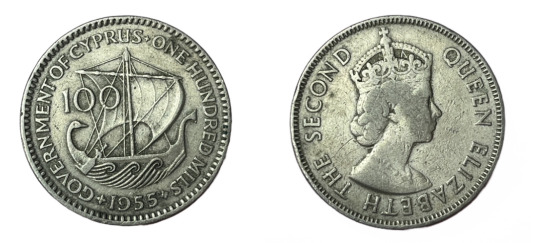
In 1955 an insurgency by National Organisation of Cypriot Fighters (EOKA) led to the Governor General Sir John Harding declaring a state of emergency.
0 notes
Text
Hussein Kamel (Arabic: السلطان حسين كامل) was declared Sultan of Egypt on 19 December 1914 during the British protectorate. He was the first person to hold the title of since the killing of Sultan Tuman II by the Ottomans in their 1517 conquest of Egypt.
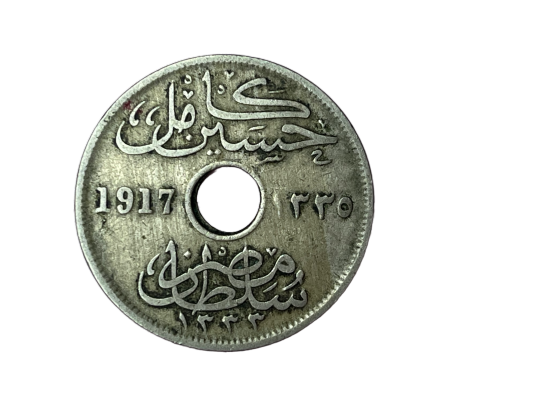

On 21 September 1917, three weeks before Hussein Kamel's death, the British chose his brother as successor, first requesting that his son Kamal el Dine renounce the throne, for the British not to appear to the Egyptian public as having deprived him of his legitimate rights.
This was the only time in Egyptian history that an eligible heir gave up his rights to the throne of his own free will.

2 Qirsh silver coin, King Farouk, Egypt 1937 - 1356 ( ١٣٥٦ -١٩٣٧ )
Farouk I (فاروق الأول) was the tenth ruler of Egypt from the Muhammad Ali dynasty and the penultimate King of Egypt and the Sudan, known for his extravagant playboy lifestyle. While initially popular, his reputation eroded due to the corruption and incompetence of his government. He was overthrown in the 1952 coup d'état, and forced to abdicate in favour of his infant son. Gamal Abdel Nasser led the coup and withdrawal of all British military personnel from Egypt. The monarchy was formally abolished on 18 June 1953: Egypt was declared a republic for the first time in its history. Following an attempt on Nasser’s life in 1954 he put the first President Mohamed Naguib under house arrest and Nasser was formally elected president in June 1956.

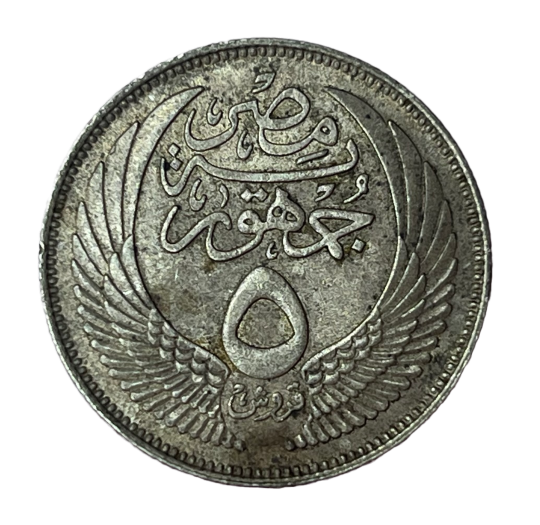
20 Qirsh silver coin, 1956, Egyptian Mint Authority, Cairo
https://en.numista.com/catalogue/pieces18943.html
In July 1956, Nasser nationalised the Suez Canal Company, previously British and French owned. After Israel invaded the Egyptian Sinai, Britain and France issued a joint ultimatum to cease fire, landing paratroopers along the Suez Canal. Before Egyptian forces were defeated, they blocked the canal by sinking 40 ships.
It later became clear that Israel, France and Britain had conspired to plan the invasion, but with the canal rendered useless, political pressure from the US and USSR led to a withdrawal. President Eisenhower had strongly warned Britain not to invade, threatening damage to the British financial system by selling sterling bonds. Historians conclude the crisis "signified the end of Britain's role as one of the world's major powers".
0 notes
Text


A unique aspect of sovereign production was the establishment of several branches of the Royal Mint outside the British Isles. No other country since the fall of the Roman Empire had spread its coin production over such a vast area. In this case policy was dictated by the enormous distances involved in the far-flung British Empire.
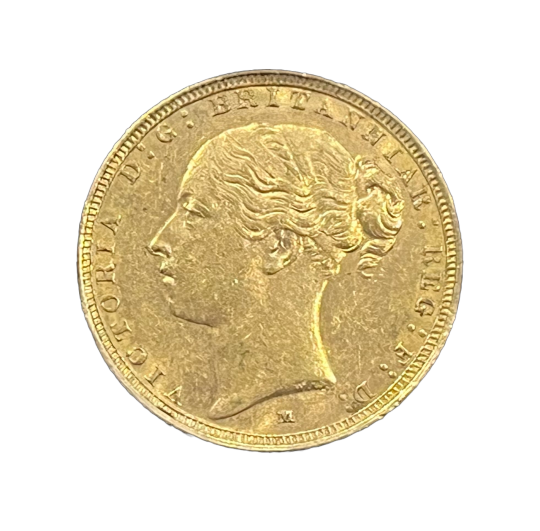

When gold was discovered in New South Wales and Victoria in the mid-nineteenth century, it seemed sensible to refine and assay the gold on the spot. The first coins struck at Sydney Mint were in 1855 and at Melbourne in 1872.


Before the Federation of Australia in 1901, British shillings were shipped around the world to serve as currency for the British Empire and the first Australian shillings were struck at the Heaton Mint in Birmingham and the Royal Mint in London. In 1916 the first Australian coins to be struck in Australia were shillings produced at the Melbourne Mint.
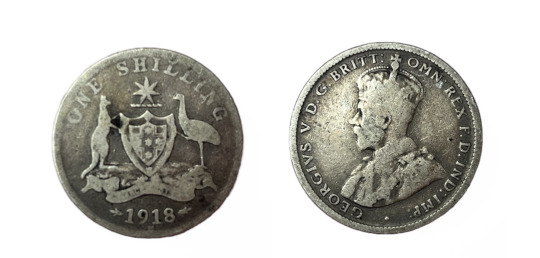
2 notes
·
View notes
Text
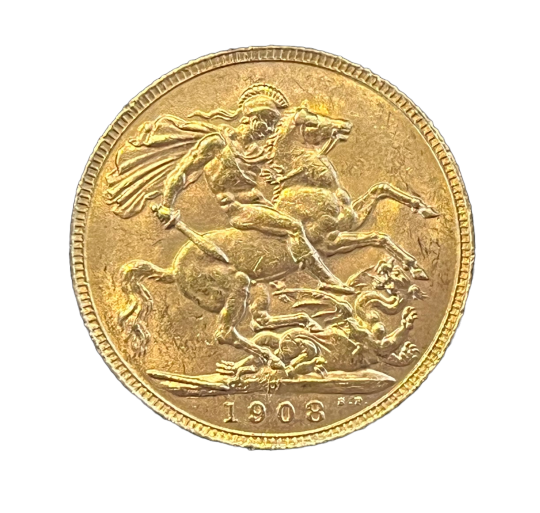

Edward VII gold sovereign, 1908 Perth Mint (P above date)
Perth Mint was established during the 1890s, as a subsidiary of the Royal Mint. At that time, the population of Western Australia was growing rapidly due to the discovery of rich gold deposits at Coolgardie and Kalgoorlie.
The death of Queen Victoria in January 1901 meant that the Prince of Wales, Albert Edward, now King Edward VII, was unable to undertake a planned tour of the British Dominions. Instead, he sent his son George, Duke of Cornwall and York, on the extensive eight-month voyage. At Perth mint the Duke and his wife Mary were presented with a casket containing two Perth Mint gold sovereigns and two half-sovereigns. The Mint remained under the control of the UK government for 69 years.


0 notes
Text

British Iron Age, CATUVELLAUNI, Cunobelin (8-41 AD), Stater, Linear type [class 2], ear of barley with five pairs of grains dividing [c]amv, rev. horse bounding right with ladder mane, branch and two pellets above, cv[n] below, 5.42g/12h (Sills 551; ABC 2774; VA 1925-1; S 281). Die break on obverse, good very fine, attractive rosy gold [Noonans auction April 2023]
From numismatic evidence, Cunobelin appears to have taken power after the death of his father Tasciovanus, and following the Roman defeat in the Battle of the Teutoburg Forest, Germania in AD 9, which possibly emboldened him to act against the Trinovantes capital at Camulodunem. The Trinovantes were a Roman ally whose independence was protected by a treaty they made with Julius Caesar in 54 BC, but problems in Germania severely discouraged Augustus's territorial ambitions and ability to defend allies in Britain. Cunobelin’s aggressive policy of expansion that involved members of his family eventually led to Roman concern over the extent of his power, Suetonius calling him ‘king of the Britons’. Following his death just prior to AD 43 the emperor Claudius took the decision to invade Britain, and the minting of tribal coins ceased shortly afterwards.
0 notes
Text

LVDOVICVS . MAGNVS . REX . SVFFICIT * NEC * DEFICIT * TRESOR.ROYAL. MDCLXXXV (1685)
‘Sufficient is never enough’. On 15 October 1685, Louis issued the Edict of Fontainebleau, which revoked the Edict of Nantes. Protestant groups were no longer tolerated in France. No further Protestant churches were to be constructed, and those already existing were to be demolished. Pastors could choose either exile or secular life. Those Protestants who had resisted conversion were now to be baptised forcibly into the established church.

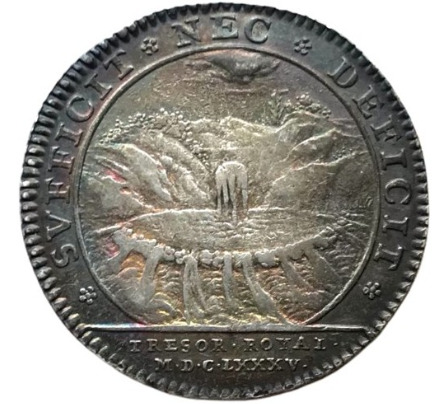
0 notes
Text


Until the early 19th century, Guernsey used predominantly French currency. Coins of the French livre were legal tender until 1834, with French francs used until 1921. In 1830, Guernsey began production of copper coins denominated in doubles. The double was worth 1⁄80 of a French franc. The name "double" derived from the French "double deniers".
0 notes
Text
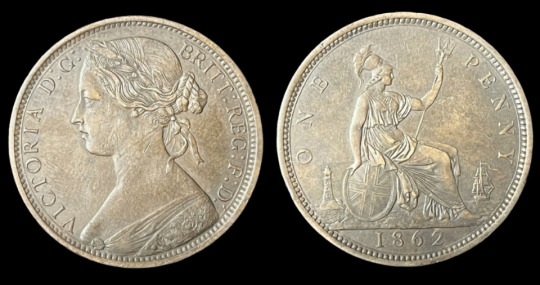
“In reference to your email and image of your 1862 penny I can confirm 100% that the obverse image of the 1862 is NOT what Spink would call obverse 2 (My obverse D) but the very common Spink obverse type 6 (My obverse J). i.e with 16 leaves and NO signature below bust.

Spink Obverse 2 (My obverse D) would have 15 leaves and the signature L. C. WYON, raised, on the lower part of the back of the Victoria’s bust.”
[email reply to my enquiry, from Michael Gouby, 6th Feb 2023, http://www.michael-coins.co.uk/ ]
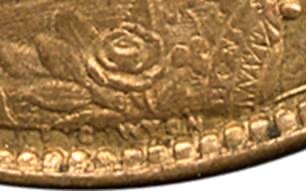

0 notes
Text
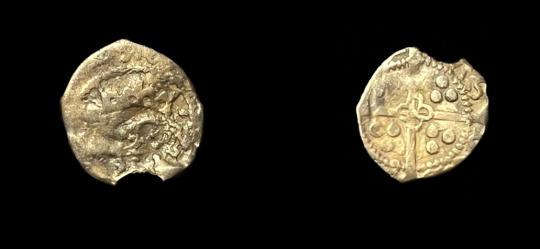
Image1: uncertain penny, York mint
“The quatrefoil at the centre of the reverse cross was first used on ecclesiastical coins of York in 1280 at the start of Edward I's recoinage. It is believed by some to represent the bow of the key to York Minster. It was subsequently used on some of the Irish pennies of Edward IV, and your image2 is in fact a penny of Dublin” [email reply by Rod Blunt, 1st Feb 2023]
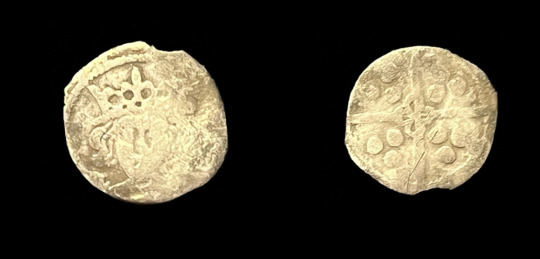
Image2: Edward IV penny, Dublin mint, Spink 6361

Image3: Late 15th century penny, York mint
Unfortunately, despite the appreciable number of surviving pennies of York, the condition of the great majority of them is very poor. This is mainly due to the dies having been used well beyond their normal serviceable life, rather than as a result of wear or abuse in circulation, although these factors will also have taken their toll in some cases. [Rod Blunt, available at https://www.rodblunt.com/ ]
0 notes
Text
During the early 15th and early 16th centuries the English economy experienced so serious a shortage of English-struck halfpennies that people began using foreign coinage to fill the gap. The coin they used was the Venetian soldino.

Tommaso Mocenigo (1414-1423)
Obv: + TOM MOCENIG DVX Doge standing left, holding banner. Rev: + S MARCVS VENETI (Saint Mark, Venice). Winged lion of St Mark, holding book of gospels, all within inner circle
The Venetians were notorious traders in the late medieval period with trade networks covering the Mediterranean and Europe. The Venetian fleet of galleys set out for England during May and stayed there until late August or early September, During these summer months soldini entered the English economy through trade with Venetian merchants and quickly became widespread across England. The soldino, meaning ‘little shilling’ became nicknamed the ‘galyhalpens’, or Galley-halfpence, after the ‘Galley-men’ who imported them.

Francesco Foscari (1423-1457)
Obv: FRA FOSCARI DVX Doge standing left, holding banner. Rev: + S MARCVS VENETI (Saint Mark, Venice)
0 notes
Text

Edward I penny, Durham mint, CIVITAS DVNELM, Bishop Bek with mint mark cross moline (Spink 1423)
The mint at Durham, like that at Bury, was an ecclesiastical establishment, the profits of which were normally due to the bishop, not the king. The earlier types are identifiable by the city’s name alone, but, from the time of Antony Bek (elected 1283), they also include a personal mark denoting the incumbent bishop. In Bek’s case, the mark is a cross moline, which usually occurs as an obverse initial mark in place of the usual cross pattée. [Rod Blunt]
The name moline derives from its shape, which resembles a millrind, the iron clamp of the upper millstone, moline being the Old French for a mill.
0 notes
Text

This unusual looking coin was found in a field south of Watlington village, Oxfordshire. I asked Edwardian penny expert, Rod Blunt, whether he thought it could be a cast copy.
He believes it to be a contemporary forgery of an Edward I or Edward II penny. It might be struck rather than cast, as the legends and individual letters are completely blundered, suggesting an illiterate die-cutter. If casting, a counterfeiter would most likely use a genuine coin as a pattern. The material is uncertain, but possibly either base silver, or silver obtained by clipping genuine coins. Although of unconvincing style, it would probably pass fairly easily between most people at the time.
0 notes
Text
Short cross short stories.

A folded silver coin found metal detecting on the Isle of Wight.
Many folded coins are found near major pilgrimage centres in Britain, such as Hereford and Winchester, where pilgrims brought them to a saint to whom they had earlier prayed to for help, normally prayers for healing for themselves or others. They were often first folded over the head of the sufferer.
Although advised to leave it as it was, I decided to straighten it out over a gas flame. The portrait of Henry II was revealed after being hidden for 800 years.
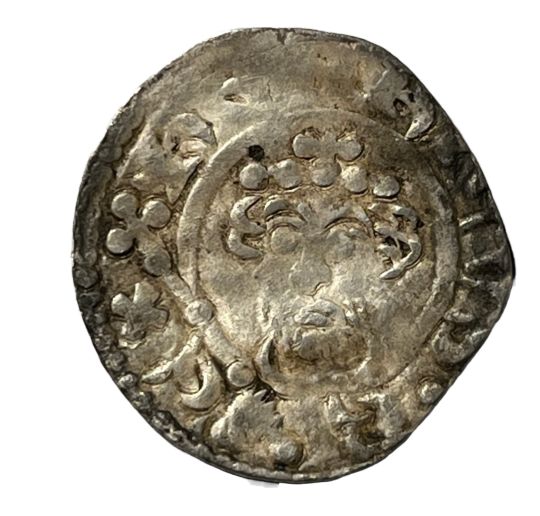
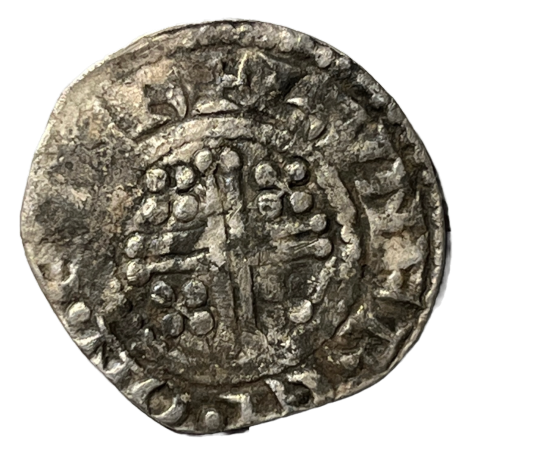
Henry II shortcross penny, Class 1b1 (1180-c.1182) - Spink 1344. HENRICVS REX moyener HVNFREI . ON . EVER (York mint)
Class 1b1 coins are notable for the high quality of design and production. The hair-curls are now in a standard 2/5 configuration with the two on the left arranged one above the other, and the five on the right also arranged vertically with parallel pairs in the top and middle rows, and a single one at the bottom. The letter N has four serifs, which is a key factor in differentiating from 1b2. A pellet stop between the two words on the obverse is present on most coins. [Rod Blunt]
Another short cross penny was found by a footpath leading to Ye Olde Bell at Hurley. Ye Olde Bell was founded in 1135 as the hostelry of Hurley Priory, making it one of the oldest hotels in the world. The coaching inn expanded in the 12th century to include a tithe barn and dovecote.
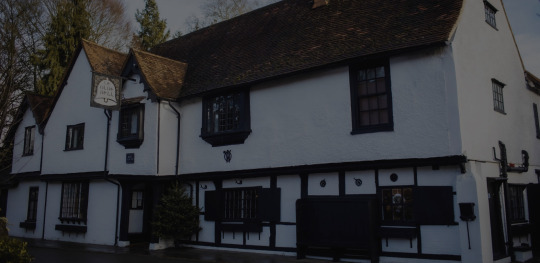
By 1204 King John had lost most of his ancestral lands in France to King Philip II and had struggled to regain them for many years. Within a few months after his return from France in October 1214, John found that rebel barons in the north and east of England were organising resistance to his rule. Perhaps the coin was lost by one of the barons on his travels.

King John penny, Class 5c (1207-c.1210). London moyener WALTER, double struck reverse. WALTER · ON · LVN (VN ligulate), (SCBI Mass 1698 var.; N 971; S 1352).
All class 5 coins were struck during the reign of John, and are of markedly better style and execution than their immediate predecessors, the result of measures taken to address the poor state into which the coinage had fallen. The king's hair is depicted by two or three large ringlets (often with a central pellet) on each side of the head. The beard consists of a line of neat vertically inclined strokes along each side of the face and under the chin, where they often flank a central pellet. The crown band usually consists of five pellets. The defining feature of class 5c coins is the letter X in REX, which has wedge-shaped limbs, often no longer at ninety degrees. The bust tends towards a rounder shape and the eyes, no longer broken, are increasingly lentoid. [Rod Blunt]
0 notes
Text

Charles II shilling 1676, 2nd bust, unrecorded variety. I contacted shilling expert Gary Oddie, who confirmed this. My coin is shown as Fig.1 in the research blog of the British Numismatic Society.



0 notes
Text
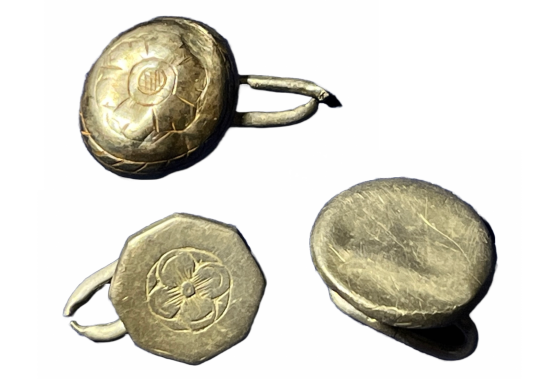
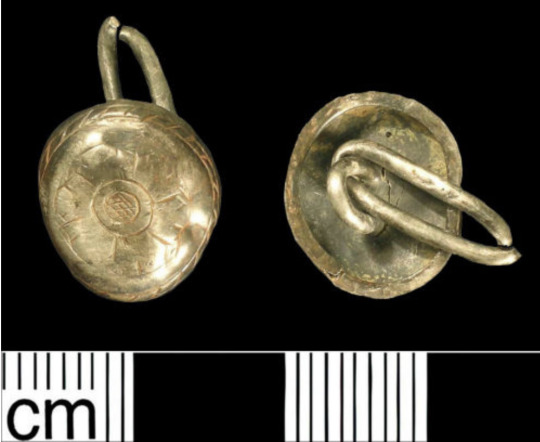
Top left is a silver cufflink of 17th to 18th century date, recorded with Geoff Egan, PAS. I’ve since found the others.
The object comprises a round stamped sheet. The upper surface is engraved with a rose in a corded border. On the reverse survives an oval wire link. A makers stamp, possibly reading 'E' or 'LB', is located on the wire.
0 notes

